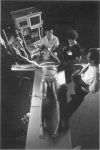Full text
PDF




Images in this article
Selected References
These references are in PubMed. This may not be the complete list of references from this article.
- Devitt J. H., Kurrek M. M., Cohen M. M., Fish K., Fish P., Murphy P. M., Szalai J. P. Testing the raters: inter-rater reliability of standardized anaesthesia simulator performance. Can J Anaesth. 1997 Sep;44(9):924–928. doi: 10.1007/BF03011962. [DOI] [PubMed] [Google Scholar]
- Devitt J. H., Kurrek M. M., Cohen M. M., Fish K., Fish P., Noel A. G., Szalai J. P. Testing internal consistency and construct validity during evaluation of performance in a patient simulator. Anesth Analg. 1998 Jun;86(6):1160–1164. doi: 10.1097/00000539-199806000-00004. [DOI] [PubMed] [Google Scholar]
- Gallagher E. J., Coffey J., Lombardi G., Saef S. Emergency procedures important to the training of emergency medicine residents: who performs them in the emergency department? Acad Emerg Med. 1995 Jul;2(7):630–633. doi: 10.1111/j.1553-2712.1995.tb03602.x. [DOI] [PubMed] [Google Scholar]
- Howard S. K., Gaba D. M., Fish K. J., Yang G., Sarnquist F. H. Anesthesia crisis resource management training: teaching anesthesiologists to handle critical incidents. Aviat Space Environ Med. 1992 Sep;63(9):763–770. [PubMed] [Google Scholar]
- Kardash K., Tessler M. J. Videotape feedback in teaching laryngoscopy. Can J Anaesth. 1997 Jan;44(1):54–58. doi: 10.1007/BF03014325. [DOI] [PubMed] [Google Scholar]
- Kurrek M. M., Fish K. J. Anaesthesia crisis resource management training: an intimidating concept, a rewarding experience. Can J Anaesth. 1996 May;43(5 Pt 1):430–434. doi: 10.1007/BF03018101. [DOI] [PubMed] [Google Scholar]
- Ma O. J., Bentley B., 2nd, Debehnke D. J. Airway management practices in emergency medicine residencies. Am J Emerg Med. 1995 Sep;13(5):501–504. doi: 10.1016/0735-6757(95)90156-6. [DOI] [PubMed] [Google Scholar]
- Riley R. H., Wilks D. H., Freeman J. A. Anaesthetists' attitudes towards an anaesthesia simulator. A comparative survey: U.S.A. and Australia. Anaesth Intensive Care. 1997 Oct;25(5):514–519. doi: 10.1177/0310057X9702500510. [DOI] [PubMed] [Google Scholar]
- Sakles J. C., Laurin E. G., Rantapaa A. A., Panacek E. A. Airway management in the emergency department: a one-year study of 610 tracheal intubations. Ann Emerg Med. 1998 Mar;31(3):325–332. doi: 10.1016/s0196-0644(98)70342-7. [DOI] [PubMed] [Google Scholar]
- Schwartz D. E., Matthay M. A., Cohen N. H. Death and other complications of emergency airway management in critically ill adults. A prospective investigation of 297 tracheal intubations. Anesthesiology. 1995 Feb;82(2):367–376. doi: 10.1097/00000542-199502000-00007. [DOI] [PubMed] [Google Scholar]
- van Meurs W. L., Good M. L., Lampotang S. Functional anatomy of full-scale patient simulators. J Clin Monit. 1997 Sep;13(5):317–324. doi: 10.1023/a:1007456108111. [DOI] [PubMed] [Google Scholar]




